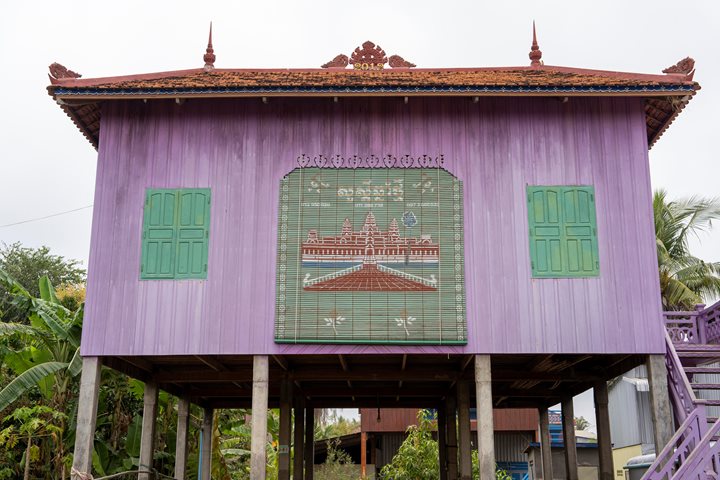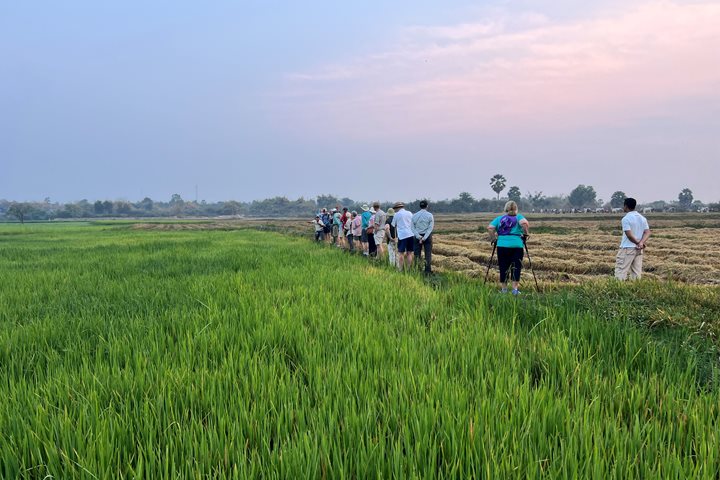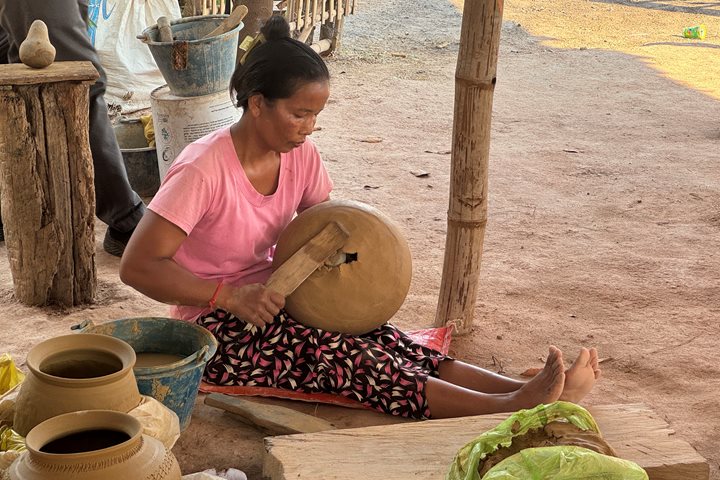Siem Reap, Cambodia
Shocking, the morning after a splendid reception and dinner at La Résidence the previous evening, to rouse ourselves a little after 4a.m., gather up camera, insect repellent, sunscreen and, most important, powerful little LED flashlight. Then down to poolside to be fuelled for our morning excursion with coffee and croissants.
At 5:10a.m., we board our three buses for the short trip out to magnificent Angkor Wat, the largest Vishnu temple and arguably the largest religious building in world. It is still pitch dark, but we have been advised that we must be at the west entrance at least 45 minutes ahead of sunrise (which, today, is at 6:20a.m.). Our objective is to observe the spectacular sunrise over the iconic Wat. Our flashlights are a “must” as we navigate the long causeway, which seems much narrower than it does in daylight (no guardrails, so hug the centre) and enter the west gateway. We are escorted around a narrow ledge (watch that drop-off) inside the massive outer wall and take our places where we can get the best view of the towers. As the sky over the temple turns pink, cicadas break into song over by the modern Buddhist monastery to our left. And then, emerging from a low cloudbank to the east, the sun: just to the right of the tallest central tower, exactly as ancient Khmer astronomers predicted. We are a few days short of the Spring Equinox, when the sun will rise precisely over that main tower. The photographers go mad.
Making our way to the “happy room” and beyond, we are treated to a concert of Khmer music played by young disabled acolytes near the monastery. We stop by the reflecting pool where the avid photographers can zero in on the wat and its image—unfortunately a little obscured by the low water of the dry season in Cambodia. We continue along the north side of the temple and stop to greet a large family of fearless, and very healthy, macaque monkeys, which are not hesitant to snatch food and items of clothing from unwary tourists. They are of all shapes and sizes from a newborn clinging to his mother’s breast to large and torpid grandmothers squatting along the pathway supervising the brood. Interesting how these animals have settled in this one area of the wat, with swift access if need be to the greenery nearby.
But our attention is drawn to our main goal: the wooden stairway built to permit access to the lower platform of the Wat without further damaging the stone steps, eroded by a thousand years of use. On the way, we notice a single Buddhist nun, in characteristic white robe, meditating on a patch of grass, oblivious to the stream of visitors passing by. We realize that this is, and has been for centuries, an active Buddhist place of workship. In spite of the numbers of travellers, and probably because we are not here at the height of the tourism season, there is an air of tranquillity. Entering the lower galleries, we walk by some of the magnificent bas-relief friezes; if one should be really serious about understanding and analyzing the stories depicted here—the Ramayana, the Mahabaratha, the depictions of the king and his court, the interactions between heaven and hell and the “churning of the sea of milk” (which we will return to as we later enter the neighbouring Angkor Thom)—we could easily spend a day or more here, but time is short.
On the second level, we note again the magnificently rendered carvings of Apsara dancers. Someone comments that “these cannot be Khmer women; they are far too well endowed on top”; I respond that these are celestial virgin dancers and “Indian” in provenance. We can look up at the temple mountain where the Hindu gods, to whom this confusing Hindu/Buddhist temple was dedicated, reside. Those who care to brave the 47 steps to the top have a wonderful view of the vast temple grounds and beyond. To the west, we see that some clever entrepreneur is offering rides in a tethered hot air balloon: no more than 200 metres off the ground, but a great adventure, especially for local tourists from the Cambodian countryside. An encouraging feature of the Angkor complex is that Cambodian citizens may enter free of charge.
La Résidence provides its usual excellent breakfast/brunch, which might be enough for any ordinary mortal to skip lunch. Off go the more energetic participants to visit the markets or to try lunch at the classic Grand Hotel d’Angkor and to be disappointed that the “Elephant Bar,” strongly recommended by an old Siem Reap hand, who shall remain nameless, is closed until 4:00p.m.
In the afternoon, we board a convoy of “tuk-tuk”s, a Thai name for what the Cambodians used to know as “ramok” (from the French “remorque”), a large rickshaw-like vehicle drawn by a powerful motor scooter. Arriving at the giant gate of Jayavarman VII’s “Angkor Thom” (Great City), we head immediately for yet another iconic temple, the Bayon. Originally built along the lines of other Hindu temples, with high towers, this was converted by Jayavarman VII, himself a late convert to Buddhism, into a Mahayana Buddhist edifice. It is unique in the world, as it features an endless display of human (or godlike) heads on the towers, most of which are topped by double lotus blossoms. In the jungle that had obscured most of the Angkor ruins by the 19th century, the French explorer André Mouhot, claims to have been surprised to see this giant face peering down at him from within the foliage. The tuk tuks take us further along the road through Angkor Thom to see the Elephant terrace and the Terrace of the Leper King, upon which once stood the gilded wooden palaces of the Kings of Angkor.
Our stay in Siem Reap is topped off with dinner at Restaurant “AHA” near the old market in the centre of the city—a fitting celebration to see us on the next stage of our expedition. Those who wish to venture further, to visit the market or essay another attempt at the Elephant Bar, are free to do so; many, however, will head back to our superb headquarters at La Résidence to prepare themselves for an early start on the road to Kampong Cham tomorrow.






